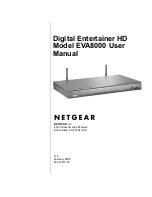
User Manual for NOP1840 PEP-Box Server
Technology
Newtec proprietary
Version 1.0
Confidentiality :
Unrestricted
Page 31 / 96
4.2
NOP1830 PEP-Box Gateway
The TelliNet Client can be configured to capture all outgoing data transparently, without any
configuration of client applications necessary.
Alternatively: on the NOP1830 PEP-Box Gateway side you configure your web browser and/or mail
reader to use the TelliNet Client Daemon as your local web proxy, FTP proxy and mail server. This
results in all HTTP, FTP over HTTP, SOCKS and POP3 requests for downloading data to be directed
to the TelliNet Client Proxy.
The TelliNet Client Proxy then connects to the TelliNet Server Proxy (e.g. at the satellite uplink site). The
backchannel connection is used for two purposes: to acknowledge data received from the Server Proxy
and to forward requests for web objects, FTP files or mail messages to the TelliNet Server Proxy.
Between TelliNet Server and TelliNet Client ETCPv2 is used, a highly efficient protocol designed to
cope with high delay and lossy networks. Using ETCPv2 allows using a high delay or lossy network as
sole communication medium, as it is e. g. the case in two-way satellite systems. Traffic load on the
backchannel is highly reduced by TelliNet. Additionally, the TelliNet Client can send the data
compressed to further reduce the bandwidth utilization on the backchannel.
4.3
NOP1840 PEP-Box Server
The TelliNet Server Proxy passes the requests received from the NOP1830 PEP-Box Gateways on to
the corresponding web, FTP and mail servers. The content/data collected by the TelliNet Server Proxy
is then passed on to the corresponding Client Proxy using ETCPv2, a highly efficient protocol designed
to cope with high delay and lossy networks.
Optionally, the TelliNet Server Proxy can compress the data during transmission, resulting in a reliable,
secure and efficient distribution service while allowing users to continue to use their standard
applications.
4.4
Authentication
If the module Authentication is activated, it is possible to restrict the usage of the TelliNet Client
software to specific recipients and even to specific hardware or IP addresses. For that purpose it is
necessary to create one or multiple Recipient Files in the TelliNet Server. Refer to
Client Management
(on page 69) for configuration.
The Recipient Files lists all available recipients. A user name is given for the recipient, a user key can
be specified as access password for the recipient and hardware dependent host keys can be included.
It is also possible to configure recipient specific restrictions in the Recipient File. A maximum allowed
bandwidth for sending and receiving data can be set and the recipient can even be excluded
completely from transmission by setting the entry "locked". Furthermore the Recipient File is used to
allocate specific TelliNet transmission parameters (e. g. multicast address scopes) to the recipient.
















































